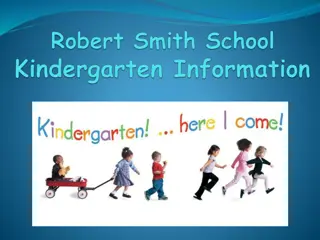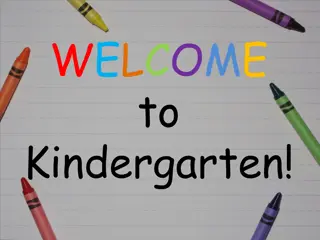Kindergarten Science Exploration Activities
Engage kindergarten students in hands-on science activities focusing on observing, recording, and discussing properties of objects, exploring changes in materials through heating and cooling, using the senses to explore energy forms, investigating magnets and interactions with materials, and describing object locations and movements. Students will also learn to observe, describe, compare, and sort rocks based on various characteristics, explore physical properties of water sources, and understand the usefulness of rocks, soil, and water in various ways.
Download Presentation

Please find below an Image/Link to download the presentation.
The content on the website is provided AS IS for your information and personal use only. It may not be sold, licensed, or shared on other websites without obtaining consent from the author. Download presentation by click this link. If you encounter any issues during the download, it is possible that the publisher has removed the file from their server.
E N D
Presentation Transcript
observe and record properties of objects, including relative size and mass, such as bigger or smaller and heavier or lighter, shape, color, and texture.[K.5A] October 2014 Elementary Science - Kindergarten
observe, record, and discuss how materials can be changed by heating or cooling.[K.5B] October 2014 Elementary Science - Kindergarten
use the five senses to explore different forms of energy such as light, heat, and sound.[K.6A] October 2014 Elementary Science - Kindergarten
explore interactions between magnets and various materials.[K.6B] October 2014 Elementary Science - Kindergarten
observe and describe the location of an object in relation to another such as above, below, behind, in front of, and beside.[K.6C] October 2014 Elementary Science - Kindergarten
observe and describe the ways that objects can move such as in a straight line, zigzag, up and down, back and forth, round and round, and fast and slow.[K.6D] October 2014 Elementary Science - Kindergarten
observe, describe, compare, and sort rocks by size, shape, color, and texture.[K.7A] October 2014 Elementary Science - Kindergarten
observe and describe physical properties of natural sources of water, including color and clarity.[K.7B] October 2014 Elementary Science - Kindergarten
give examples of ways rocks, soil, and water are useful.[K.7C] October 2014 Elementary Science - Kindergarten
observe and describe weather changes from day to day and over seasons.[K.8A] October 2014 Elementary Science - Kindergarten
identify events that have repeating patterns, including seasons of the year and day and night.[K.8B] October 2014 Elementary Science - Kindergarten
observe, describe, and illustrate objects in the sky such as the clouds, Moon, and stars, including the Sun.[K.8C] October 2014 Elementary Science - Kindergarten
differentiate between living and nonliving things based upon whether they have basic needs and produce offspring.[K.9A] October 2014 Elementary Science - Kindergarten
examine evidence that living organisms have basic needs such as food, water, and shelter for animals and air, water, nutrients, sunlight, and space for plants.[K.9B] October 2014 Elementary Science - Kindergarten
sort plants and animals into groups based on physical characteristics such as color, size, body covering, or leaf shape.[K.10A] October 2014 Elementary Science - Kindergarten
identify parts of plants such as roots, stem, and leaves and parts of animals such as head, eyes, and limbs.[K.10B] October 2014 Elementary Science - Kindergarten
identify ways that young plants resemble the parent plant.[K.10C] October 2014 Elementary Science - Kindergarten
observe changes that are part of a simple life cycle of a plant: seed, seedling, plant, flower, and fruit.[K.10D] October 2014 Elementary Science - Kindergarten























